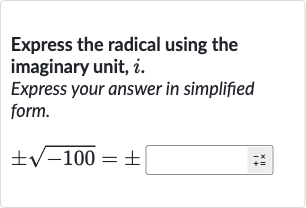Full solution
Q. Express the radical using the imaginary unit, .Express your answer in simplified form.
- Recognizing the imaginary unit: First, we recognize that the square root of a negative number involves the imaginary unit , where . We can rewrite the expression by factoring out the negative as the square root of times the square root of .
- Factoring out the negative: Next, we know that is equal to , and is equal to . So we can express as .
- Simplifying the expression: Now, we simplify the expression by multiplying with the square root of , which is . This gives us , which can be written as .
- Final simplified complex number form: Finally, we have the expression in its simplest form, which is . This is the simplified complex number form of the original expression .
More problems from Introduction to complex numbers
QuestionGet tutor help
QuestionGet tutor help
QuestionGet tutor help
QuestionGet tutor help
QuestionGet tutor help

